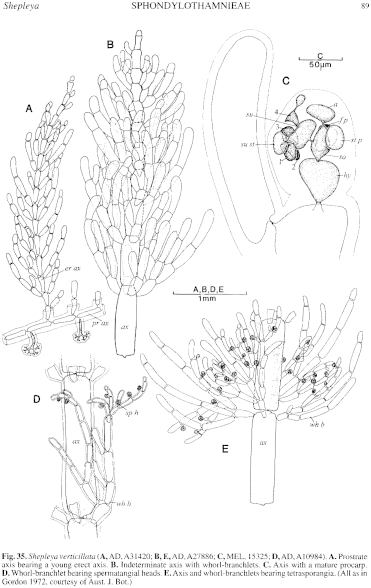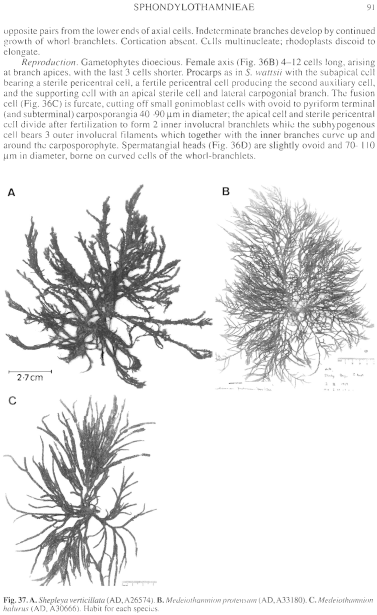|
|
|
|
|
|||||||||||
|
Electronic Flora of South Australia Species Fact Sheet
Phylum Rhodophyta – Order Ceramiales – Family Ceramiaceae – Tribe Sphondylothamnieae
Synonym
Wrangelia verticillata Harvey 1863, synop.: xxviii. J. Agardh 1876: 619. De Toni 1897: 130. Guiler 1952: 99. Lucas 1909: 23; 1929b: 48. Lucas & Perrin 1947: 138, W incurva J. Agardh (nom. nud.). Gordon 1972: 39. May 1965: 365. Tisdall 1898: 511. Wilson 1892: 170.
Thallus (Fig. 37A) medium red-brown, fading to grey, 15–30 cm high, with alternate, spreading, sparse to moderately dense branching for 3–4 orders; erect axes often basally entwined, arising from prostrate axes (Fig. 35A). Holdfast rhizoidal, 3–8 mm across, attached by haptera; epilithic. Structure. Subapical cells bearing 4 orthostichous whorl-branchlets (Fig. 35B) in opposite pairs, the second pair initiated several cells below the first pair, with the axial cells enlarging to 500–600 µm in diameter and 2–2.5 mm long near the base; mature whorl-branchlets are slightly incurved, 1.4–2.2 mm and 4–5 cells long, cells tapering only slightly, median cells 130–150 µm in diameter and L/D 3–5, the basal cell bearing 2–3 and the next cell 1–2 adaxial branchlets, terminal cells with rounded ends. Indeterminate branches arise in the position of whorl-branchlets on axial cells. Cortication of the lower thallus is by rhizoids from the basal cell(s) of whorl-branchlets, adhering to the axis by haptera. Cells multinucleate; rhodoplasts discoid to elongate.
Reproduction: Gametophytes dioecious, occasionally with mixed-phase thalli. Female axis 4–7 cells long, in the position of, or on, whorl-branchlets, with the last 3 cells shorter; procarp structure (Fig. 35C) as in S. wattsii, but the larger subhypogenous cell bearing only a single lateral at fertilization. Carposporophyte 350–450 µm across, with a large furcate fusion cell involving the hypogenous cell, carposporangia 45–60 µm in diameter, surrounded by an inner involucrum of small-celled filaments from sterile cells of the procarp, and an outer involucrum of 4 branchlets from the subhypogenous cell. Spermatangial heads (Fig. 35D) are slightly ovoid, 70–95 µm in diameter, borne adaxially on cells of whorl-branchlets.
Tetrasporangia (Fig. 35E) are sessile and adaxial on the upper ends of slightly smaller whorl-branchlet cells, 100–160 µm in diameter, tetrahedrally divided.
Type from Western Port, Vic.; lectotype in Herb. Harvey, TCD (Alg. Aust. Exsicc. 260).
Selected specimens: Gleeson Landing, Yorke Pen., S. Aust., drift (Fagg, 12.iv.1968; AD, A31390). Brown Beach, Yorke Pen., S. Aust., 6–12 m deep (Shepherd, 14.iv.1963; AD, A26574). West Bay, Kangaroo I., S. Aust., drift (Womersley, 6.i.1946; AD, A3257). Guichen Bay, S. Aust., 10–16 m deep (Womersley, 1.ix.1949; AD, A10984). Robe, S. Aust., shaded pool (Womersley, 7.xi.1965; AD, A29650). Stinky Bay, Nora Creina, S. Aust., drift (Baldock, 19.v.1964; AD, A27886) and (Gordon, 15.v.1967; AD, A31420). Warrnambool, Vic., (Kraft 8092 & Herrington, 19.xi.1989; AD, A67801). 1.3 km off Cape Northumberland, S. Aust., 15 m deep (Shepherd, 17.v.1978; AD, A55203). Port Phillip Heads, Vic. (Wilson, 1.ii.1893; MEL, 15325).
Distribution: Gleeson Landing, Yorke Pen., and West Bay, Kangaroo I., S. Aust., to Western Port, Victoria.
References:
AGARDH, J.G. (1876). Species Genera et Ordines Algarum. Vol. 3, Part 1- Epicrisis systematic Floridearum, pp. i-vii, 1–724. (Weigel: Leipzig.)
DE TONI, G.B. (1897). Sylloge Algarum omnium hucusque Cognitarum. Vol. 4. Florideae. Sect. 1, pp. 1–388. (Padua.)
GORDON, E.M. (1972). Comparative morphology and taxonomy of the Wrangelieae, Sphondylothamnieae and Spermothamnieae (Ceramiaceae, Rhodophyta). Aust. J. Bot. suppl. 4, 1–180.
GUILER, E.R. (1952). The marine algae of Tasmania. Checklist with localities. Pap. Proc. R. Soc. Tasmania 86, 71–106.
HARVEY, W.H. (1863). Phycologia Australica. Vol. 5, Plates 241–300, synop., pp. i-lxxiii. (Reeve: London.)
LUCAS, A.H.S. & PERRIN, F. (1947). The Seaweeds of South Australia. Part 2. The Red Seaweeds. (Govt Printer: Adelaide.)
LUCAS, A.H.S. (1909). Revised list of the Fucoideae and Florideae of Australia. Proc. Linn. Soc. N.S.W. 34, 9–60.
LUCAS, A.H.S. (1929b). A census of the marine algae of South Australia. Trans. R. Soc. S. Aust. 53, 45–53.
MAY, V. (1965). A census and key to the species of Rhodophyceae (red algae) recorded from Australia. Contr. N.S.W. natn. Herb. 3, 349–429.
TISDALL, H.T. (1898). The algae of Victoria. Rep. 7th Meet. Aust. Ass. Adv. Sci., Sydney, 1898, pp. 493–516.
WILSON, J.B. (1892). Catalogue of algae collected at or near Port Phillip Heads and Western Port. Proc. R. Soc. Vict. 4, 157–190.
The Marine Benthic Flora of Southern Australia Part IIIC complete list of references.
Publication:
Womersley, H.B.S. (24 December, 1998)
The Marine Benthic Flora of Southern Australia
Rhodophyta. Part IIIC. Ceramiales – Ceramiaceae, Dasyaceae
©State Herbarium of South Australia, Government of South Australia
Illustrations in Womersley Part IIIA, 1998: FIGS 35, 37A.

Figure 35 enlarge
Fig. 35. Shepleya verticillata (A, AD, A31420; B, E, AD, A27886; C, MEL, 15325; D, AD, A 10984). A. Prostrate axis bearing a young erect axis. B. Indeterminate axis with whorl-branchlets. C. Axis with a mature procarp. D. Whorl-branchlet bearing spermatangial heads. E. Axis and whorl-branchlets bearing tetrasporangia. (All as in Gordon 1972, courtesy of Aust. J. Bot.)

Figure 37 enlarge
Fig. 37. A. Shepleya verticiliata (AD, A26574). B. Medeiothamnion protensum (AD, A33180). C. Medeiothamnion halurus (AD, A30666). Habit for each species.

|
Email Contact: State Herbarium of South Australia |

|